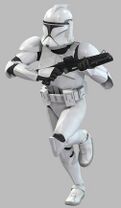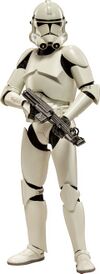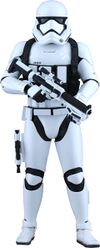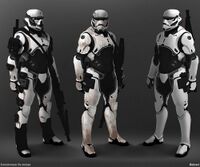Thrashian Imperial Body Armor: Difference between revisions
mNo edit summary |
mNo edit summary |
||
| (One intermediate revision by the same user not shown) | |||
| Line 22: | Line 22: | ||
===Variants=== | |||
==Material Components== | |||
==Variants== | |||
===Phase I Armor=== | |||
The first iteration of the Imperial Clone Armor Project, as it colloquially became known, was called 'Phase I Clone Armor'. The basic armor design is composed of twenty form-fitting plates of plastoid-alloy composites, sealed to a black bodysuit and weighing just under forty kilograms. The physical design was based on Mandalorian shock trooper armor and the input of Jango Fett, who was hired by Emperor Shadaum II to help design the army's equipment in addition to being the first clone template used for the Thrashian clone armies. The armor was sealed against hostile environments, capable of operating without atmosphere for up to half an hour. It's heavy armor and body-glove was intended to allow more physical projectiles to be shrugged off with greater ease. It was considered to be clunky by it's users, who didn't like the limited HUD and armor interaction. | |||
Most After Action Reports on the efficacy of the armor praised it for it's ability to allow a soldier to endure more projectile based enemy weapons fire, but laser and plasma weaponry posed a high risk due to the lacking of ablative capability and weak heat control of the lackluster body suit. It lacked any type of "powered" component, meaning that users had to rely on their own strength and endurance while wearing the armor. This was not seen as a disconcerting issue, as most users were clones designed to be at the peak of baseline human fitness, and beyond. | |||
Currently the Phase I armor is provided for civilian sale to those corporations that have been vetted by the Bastion Arms Inc. Cadets that are training to join the Imperial Army, Imperial Stormtrooper Corps, or new clones growing up to join their respective clone legions, train with this armor. [[File:Phase One Armor.jpg|thumb|left|121px]] | |||
===Phase II Armor=== | |||
The second iteration of the Imperial Clone Armor Project, the Phase II variant was a complete overhaul of the baseline. It built steadily upon the Phase I components, and took in the opinion and reviews of battlefield veterans in it's design. It incorporated all previous systems in addition to polarized lenses for it's helmet, extra padding for the body glove, and stronger, lighter armored plates that now offered some ablative capability against blaster weapons. It could also support more modular attachments, making it superior to its predecessor. | |||
The ablative nature of the armor was improved by new composite alloys in the armor plates and the body suit being re-designed with nano-fibers that were capable of dispersing heat and energy across the entire surface area of the body glove. This excess could be vented safely by simply walking, the soles of the user's boots acting as a dispersal heat sink. | |||
Other features included magnetic boots, more powerful HUD system with increased features -- such as an improved and encrypted IFF (Identify Friend or Foe) system. The body glove and armor incorporated an improved system of support for movement. Not quite powered armor, but power assisted movement helped to increase a soldier's endurance and thus their combat effectiveness. This version of clone armor is still widely used, largely due to the ability to support so many modular attachments. | |||
[[File:Phase Two Armor.jpg|thumb|left|100px]] | |||
===Phase III Armor/Stormtrooper Mk.I Armor=== | |||
The third iteration of the Imperial Clone Armor Project was when the design diverged from simply being one used by clones to being used by the Imperial Stormtrooper Corps. | |||
The Phase III/Mk.I Stormtrooper Armor was designed to be even far more effective against plasma and blaster weaponry than it's predecessors. This created weaknesses in the armor in being able to fend off projectile weaponry as effectively as it's predecessors, but the trade off for enabling a soldier to effectively "walk off" a direct blaster hit with only minor injuries or a slight concussion was seen as too advantageous. The body glove provided insulation and cushioning while also regulating body temperature during periods of exertion, allowing a soldier to sweat as much as they required and still remain at an optimal level of battle-readiness. It could also act as a compression sleeve to stem bleeding if a trooper was injured. The armor and body suit also provided limited protection against radiation, as the body glove maintained cellular integrity even in the presence of a catastrophic radiation leak. | |||
The ablative ability was useful even though the wearer would be incapacitated. Survival was considered paramount, as it would allow the trooper to receive advanced medical treatment that could return him or her to service. The breastplate was the strongest part of the armor and was sturdy enough to disperse across the surface area of the armor's plasteel all hits from blaster and other handheld energy weapons barring close-range direct impacts. | |||
The suit's advanced filtration system and controls allowed a wearer to operate in a vacuum for a maximum of one hour before requiring extraction or supplementary air supplies. Multiple modifications could be made to the armor as well. Some of the most interesting and useful included: powered gloves that could be used in hand-to-hand combat to deliver stun shocks, a manual suit seal that enabled temperature control, in-bedded power cells, increased HUD and IFF programs, a resonator for opening secure doors, and the ability to attach a personal energy shield for use during combat. | |||
The model's helmet also included new security features. A helmet's HUD and systems could be 'locked and scrambled' from being used as a small tongue-switch had to be flipped before removing the helmet; if the helmet was removed before the security switch was flipped then it's electronics would be useless until reset by a security code from a ranking officer. | |||
New HUD features included the MFTAS system; Multi-Frequency Targeting and Acquisition System. This helped users to see in multiple different spectrum, and pierce through some visual obscuring conditions such as light smoke or near-dark. | |||
The Mk.1 Stormtrooper Armor is still used by planetary governor security and police forces. It is also used by many officers of the Imperial Security Bureau, due to the environmental controls that are more advanced than Phase II Armor. | |||
[[File:Phase Three Armor.jpg|thumb|left|100px]] | |||
===Phase IV Armor/Stormtrooper Mk.II Armor=== | |||
The latest variant of Imperial Clone/Stormtrooper Armor is the Mk. II or Phase IV. It was developed as a result of battlefield experience gained during the great Chaos War. Soldiers had complained of a lack of flexibility, desiring even more than what Phase II could deliver. As such Phase IV/Mark II Armor is designed with a thicker body suit than previous iterations and more flexible plasteel armor plates. The thicker body suit came about as a result of incorporating more nano-mimetic technology into body armor design. It comes closer to being considered powered armor, but still remains within the category of power-assisted armor. The Mk. II had the benefit of being practically immune to fire, able to endure heat temperatures in excess of 1400°C. Naturally this condition could only be endured for a short period of time before it would force the suit's system to break down. | |||
[[File:Phase Four Armor.jpg|thumb|left|100px]] | |||
===Phase V Armor/EMCAP=== | |||
The latest iteration of armor that is used exclusively by the Clone Legions of the Thrashian Empire is the Phase V, or EMCAP, armor. EMCAP standing for Empowered Microbiotic Combat Armor Plate, is the first Thrashian infantry armor that is powered armor. It incorporates all of the advantages of Phase IV and II armor, but improves it with new nano and biomimetic technology. | |||
It's designed to absorb the energy created by the wearer's movement in order to power the primary suit systems. The simple act of walking a distance of 100 meters is enough to keep the suit powered for 24 hours under non-combat conditions; under combat conditions this varies according to the use to which it is being put. The armor is completely self sufficient in regards to maintaining HUD electronics and comms. Optical advancements have improved by 300% over the older Phase IV Armor; the wearer is able to see in all normal visible spectrum, as well as ultraviolet spectrum, nocturnal vision, and heat dissipation, etc. | |||
The armor itself is more resilient to absorbing thermal and plasma-based weaponry and is made from a poly-carbonate based plasteel silicone that behaves similar to ablative armor, but which can reform and repair damaged molecules given a designated length of time outside of combat. This effect is enabled by a nanite carbon form that is bound within the polymer seal. The current rate at self-repair is one square inch per thirty minutes. | |||
The fiber bundle body suit beneath it is also an important and integral design improvement. It's specifically designed to enmesh the wearer in a pressure-vacuum seal that can better withstand physical trauma and explosive decompression. Whereas the outer armor is ablative and protects against energy weaponry, the body glove is far better at protecting against kinetics. The fibre-bundles are designed from nanotechnology, developed to increase the strength of the wearer and enhance their natural agility. With this 'power suit' you can increase a normal human being's strength three times beyond maximum, peak normal. Other attributes such as reaction time and speed are also increased as a side effect. | |||
The armor and fibre-suit also have an interlinked neural implant system that interfaces between the wearer and the suit itself, allowing the wearer to mentally control any of the various functions, which also includes emergency medical tools such as pain suppressants, dopamine injectors, and adrenaline. The HUD also has a small AI-support system to assist the wearer upon command. | |||
[[File:Phase Five Armor.jpg|thumb|left|200px]] | |||
Latest revision as of 02:40, 28 April 2023
| Clone Body Armor | |
|---|---|
 Phase I-III Clone Armor | |
| Type | Combat Body Armor |
| Place of origin | Empire of Thrashia |
| Service history | |
| In service | Present |
| Used by | Empire of Thrashia |
| Production history | |
| Designer | Jango Fett |
| Manufacturer | Mandal Armorers & Bastion Arms Inc. |
| Unit cost | 3,000~ Credits |
| Variants | See Text |
Material Components
Variants
Phase I Armor
The first iteration of the Imperial Clone Armor Project, as it colloquially became known, was called 'Phase I Clone Armor'. The basic armor design is composed of twenty form-fitting plates of plastoid-alloy composites, sealed to a black bodysuit and weighing just under forty kilograms. The physical design was based on Mandalorian shock trooper armor and the input of Jango Fett, who was hired by Emperor Shadaum II to help design the army's equipment in addition to being the first clone template used for the Thrashian clone armies. The armor was sealed against hostile environments, capable of operating without atmosphere for up to half an hour. It's heavy armor and body-glove was intended to allow more physical projectiles to be shrugged off with greater ease. It was considered to be clunky by it's users, who didn't like the limited HUD and armor interaction.
Most After Action Reports on the efficacy of the armor praised it for it's ability to allow a soldier to endure more projectile based enemy weapons fire, but laser and plasma weaponry posed a high risk due to the lacking of ablative capability and weak heat control of the lackluster body suit. It lacked any type of "powered" component, meaning that users had to rely on their own strength and endurance while wearing the armor. This was not seen as a disconcerting issue, as most users were clones designed to be at the peak of baseline human fitness, and beyond.
Currently the Phase I armor is provided for civilian sale to those corporations that have been vetted by the Bastion Arms Inc. Cadets that are training to join the Imperial Army, Imperial Stormtrooper Corps, or new clones growing up to join their respective clone legions, train with this armor.
Phase II Armor
The second iteration of the Imperial Clone Armor Project, the Phase II variant was a complete overhaul of the baseline. It built steadily upon the Phase I components, and took in the opinion and reviews of battlefield veterans in it's design. It incorporated all previous systems in addition to polarized lenses for it's helmet, extra padding for the body glove, and stronger, lighter armored plates that now offered some ablative capability against blaster weapons. It could also support more modular attachments, making it superior to its predecessor.
The ablative nature of the armor was improved by new composite alloys in the armor plates and the body suit being re-designed with nano-fibers that were capable of dispersing heat and energy across the entire surface area of the body glove. This excess could be vented safely by simply walking, the soles of the user's boots acting as a dispersal heat sink.
Other features included magnetic boots, more powerful HUD system with increased features -- such as an improved and encrypted IFF (Identify Friend or Foe) system. The body glove and armor incorporated an improved system of support for movement. Not quite powered armor, but power assisted movement helped to increase a soldier's endurance and thus their combat effectiveness. This version of clone armor is still widely used, largely due to the ability to support so many modular attachments.
Phase III Armor/Stormtrooper Mk.I Armor
The third iteration of the Imperial Clone Armor Project was when the design diverged from simply being one used by clones to being used by the Imperial Stormtrooper Corps.
The Phase III/Mk.I Stormtrooper Armor was designed to be even far more effective against plasma and blaster weaponry than it's predecessors. This created weaknesses in the armor in being able to fend off projectile weaponry as effectively as it's predecessors, but the trade off for enabling a soldier to effectively "walk off" a direct blaster hit with only minor injuries or a slight concussion was seen as too advantageous. The body glove provided insulation and cushioning while also regulating body temperature during periods of exertion, allowing a soldier to sweat as much as they required and still remain at an optimal level of battle-readiness. It could also act as a compression sleeve to stem bleeding if a trooper was injured. The armor and body suit also provided limited protection against radiation, as the body glove maintained cellular integrity even in the presence of a catastrophic radiation leak.
The ablative ability was useful even though the wearer would be incapacitated. Survival was considered paramount, as it would allow the trooper to receive advanced medical treatment that could return him or her to service. The breastplate was the strongest part of the armor and was sturdy enough to disperse across the surface area of the armor's plasteel all hits from blaster and other handheld energy weapons barring close-range direct impacts.
The suit's advanced filtration system and controls allowed a wearer to operate in a vacuum for a maximum of one hour before requiring extraction or supplementary air supplies. Multiple modifications could be made to the armor as well. Some of the most interesting and useful included: powered gloves that could be used in hand-to-hand combat to deliver stun shocks, a manual suit seal that enabled temperature control, in-bedded power cells, increased HUD and IFF programs, a resonator for opening secure doors, and the ability to attach a personal energy shield for use during combat.
The model's helmet also included new security features. A helmet's HUD and systems could be 'locked and scrambled' from being used as a small tongue-switch had to be flipped before removing the helmet; if the helmet was removed before the security switch was flipped then it's electronics would be useless until reset by a security code from a ranking officer.
New HUD features included the MFTAS system; Multi-Frequency Targeting and Acquisition System. This helped users to see in multiple different spectrum, and pierce through some visual obscuring conditions such as light smoke or near-dark.
The Mk.1 Stormtrooper Armor is still used by planetary governor security and police forces. It is also used by many officers of the Imperial Security Bureau, due to the environmental controls that are more advanced than Phase II Armor.
Phase IV Armor/Stormtrooper Mk.II Armor
The latest variant of Imperial Clone/Stormtrooper Armor is the Mk. II or Phase IV. It was developed as a result of battlefield experience gained during the great Chaos War. Soldiers had complained of a lack of flexibility, desiring even more than what Phase II could deliver. As such Phase IV/Mark II Armor is designed with a thicker body suit than previous iterations and more flexible plasteel armor plates. The thicker body suit came about as a result of incorporating more nano-mimetic technology into body armor design. It comes closer to being considered powered armor, but still remains within the category of power-assisted armor. The Mk. II had the benefit of being practically immune to fire, able to endure heat temperatures in excess of 1400°C. Naturally this condition could only be endured for a short period of time before it would force the suit's system to break down.
Phase V Armor/EMCAP
The latest iteration of armor that is used exclusively by the Clone Legions of the Thrashian Empire is the Phase V, or EMCAP, armor. EMCAP standing for Empowered Microbiotic Combat Armor Plate, is the first Thrashian infantry armor that is powered armor. It incorporates all of the advantages of Phase IV and II armor, but improves it with new nano and biomimetic technology.
It's designed to absorb the energy created by the wearer's movement in order to power the primary suit systems. The simple act of walking a distance of 100 meters is enough to keep the suit powered for 24 hours under non-combat conditions; under combat conditions this varies according to the use to which it is being put. The armor is completely self sufficient in regards to maintaining HUD electronics and comms. Optical advancements have improved by 300% over the older Phase IV Armor; the wearer is able to see in all normal visible spectrum, as well as ultraviolet spectrum, nocturnal vision, and heat dissipation, etc.
The armor itself is more resilient to absorbing thermal and plasma-based weaponry and is made from a poly-carbonate based plasteel silicone that behaves similar to ablative armor, but which can reform and repair damaged molecules given a designated length of time outside of combat. This effect is enabled by a nanite carbon form that is bound within the polymer seal. The current rate at self-repair is one square inch per thirty minutes.
The fiber bundle body suit beneath it is also an important and integral design improvement. It's specifically designed to enmesh the wearer in a pressure-vacuum seal that can better withstand physical trauma and explosive decompression. Whereas the outer armor is ablative and protects against energy weaponry, the body glove is far better at protecting against kinetics. The fibre-bundles are designed from nanotechnology, developed to increase the strength of the wearer and enhance their natural agility. With this 'power suit' you can increase a normal human being's strength three times beyond maximum, peak normal. Other attributes such as reaction time and speed are also increased as a side effect.
The armor and fibre-suit also have an interlinked neural implant system that interfaces between the wearer and the suit itself, allowing the wearer to mentally control any of the various functions, which also includes emergency medical tools such as pain suppressants, dopamine injectors, and adrenaline. The HUD also has a small AI-support system to assist the wearer upon command.




